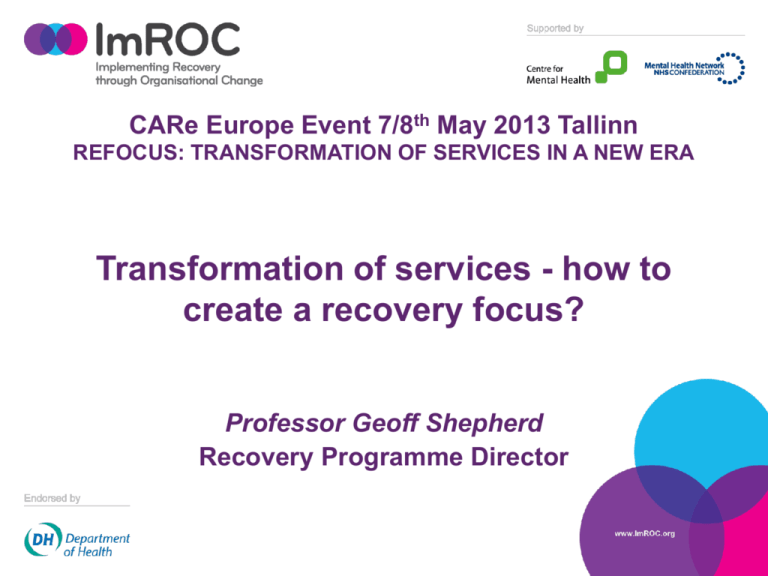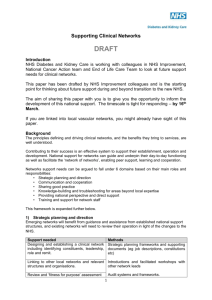- CARe Europe
advertisement

CARe Europe Event 7/8th May 2013 Tallinn REFOCUS: TRANSFORMATION OF SERVICES IN A NEW ERA Transformation of services - how to create a recovery focus? Professor Geoff Shepherd Recovery Programme Director “The greatest danger for most of us is not in setting our aim too high and falling short, but in setting our aim too low and achieving our mark.” Michelangelo (1475-1564) Mental Health Services and the NHS The NHS is a national service (arrangements are slightly different in England, Scotland, Wales and Northern Ireland). It is funded through central taxes and is free at the point of access to every citizen in need (at the moment!) Specialist mental health services are delivered by local NHS ‘Trusts’ (approx. 50 across the country) varying in size, serving populations of 750,000 – over 1 million. These are supported by primary care (GPs) who see >90% total morbidity Trusts are ‘providers’ of health services and they are funded by ‘commissioners’ who receive money from central (and local government) to purchase health and social care services (80% v. 20%). Health and social care is fairly well integrated at both a provider and a commissioner level. Currently social care is increasingly provided by the ‘independent’ sector (charities, NGOs, etc.). Implementing Recovery through Organisational Change (ImROC) A 3 year project (2009 – 2012) funded mainly by the Department of Health and delivered by a partnership between the Centre for Mental Health and the MH Network of the NHS Confederation The Project Team (all part-time) + Geoff Shepherd (Clinical psychologist, NHS manager) Julie Repper (Nurse, NHS manager) Jed Boardman (Consultant Psychiatrist) Glenn Roberts (Consultant Psychiatrist) Miles Rinaldi (Vocational manager) Dawn Fleming (Project manager) Alex Rushton (Comms. lead) Recovery and health policy (DoH/HMG, 2011) Contains 6 objectives: Objective ii. – More people with mental health problems will recover “More people who develop mental health problems will have a good quality of life – greater ability to manage their own lives, stronger social relationships, a greater sense of purpose, the skills they need for living and working, improved chances in education, better employment rates and a suitable and stable place to live” N.B. Defines ‘Personal Recovery’ not ‘Clinical’ Recovery The key principles of recovery (after Perkins & Repper, 2003) Hope – Maintaining a belief that it is still possible to pursue one’s chosen life goals. Hope is personal and relationships are central Control – The importance of personal meaning and understanding. (Re)gaining a sense of control over one’s life and one’s symptoms. Having choice over the content of interventions and sources of help. Balancing evidence with personal preference Opportunity – The need to build a life ‘beyond illness’. Being a part of the community (‘social inclusion’) not simply living in it. Having access to the same opportunities that exist for everyone else, e.g. with regard to housing, employment, social support, etc. Supporting Recovery: 2 key questions Q1 - How to change the attitudes and behaviour of staff and teams so as to make them more supportive of recovery for people using services? Q2 - How to change organisations such that these changes in staff behaviour are supported and maintained? (changing the ‘culture’) Training is not enough Whitely et al. (2009) studied implementation of Mueser’s ‘Illness Management and Recovery’ (IMR) programmes’ across 12 community settings. Training was important, but only effective if issues of supervision and leadership were also addressed. Need for a ‘culture of innovation’ in the organisation, i.e. organisations need to be ready to accept and embrace change. If all these factors were present, then they acted synergistically; however, if any were absent, then change was impeded ‘Learning together’ Recovery requires a different relationship between the people who use services and the people who provide them The emphasis must be on quality Listening to patients’ priorities Recognising what people have in common, rather than what divides them Staff as a resource (coach, mentor) rather than as the ‘expert’. Patients are experts too! Not just ‘involving’ service users, but ‘learning together’, working in partnership After each interaction, ‘Did I? ….. (from Shepherd et al., ‘10 Top Tips’ for Recovery-oriented practice) …… help the person identify and prioritise their own recovery goals? [HOPE] …….. continue to express support for the possibility of achieving these goals? [HOPE] .… actively listen and help the person make sense of their mental health problems? [MEANING] …… encourage self-management of symptoms by providing information, reinforcing coping strategies, joint crisis planning, etc. [CONTROL] …. pay particular attention to goals which take the person out of the ‘sick role’? [OPPORTUNITY] ……. identify non-mental health resources – friends, contacts, organisations – relevant to the achievement of their goals? [OPPORTUNITY] The key organisational challenges In 2008 identified 5 NHS Trusts and their local partners who had already made significant progress towards implementing more 'recoveryoriented’ services Ran a series of local workshops, involving more than 300 staff, service users, family members and managers. Formulated a list of ‘10 key Organisational Challenges’ The ‘10 key organisational challenges’ (SCMH, 2009) 1. Changing the nature of day-to-day interactions and the quality of experience 2. Delivering comprehensive, ‘co-produced’ learning programmes 3. Establishing a ‘Recovery Education Centre’ to drive the programmes forward 4. Ensuring organisational commitment, creating the ‘culture’ 5. Increasing ‘personalisation’ and choice 6. Transforming the workforce 7. Changing the way we approach risk assessment and management 8. Redefining user ‘involvement’ to create genuine ‘partnerships’ 9. Supporting staff in their recovery journey 10. Increasing opportunities for building a life ‘beyond illness’(e.g. IPS) A methodology for change The ‘Plan-Do-Study-Act’ (PDSA) cycle (Iles & Sutherland (2001) – a closed audit loop Jointly agree challenge(s) to be addressed Agree specific target (with indicators) Act (Implement) Review outcomes Repeat N.B. i. The process should be jointly owned by all the key stakeholders ii. Value of learning from others, as well as learning from experts Learning Sets Delivered 4 ‘Learning Sets’, each consisting of 6-8 sites and comprising 6 x 1 day workshops over the course of the project (i.e. approx. 3-4 months apart). Sites able to send up to 8 people to the workshop, with a mixture of NHS professionals, third sector, service users (and carers) Topics for the Learning Set were pre-chosen by the members. They covered: the ‘Organisational Journey’, ‘Staff and service users learning together’, ‘Personalisation and Choice’, ‘Creating a Recovery College’, ‘Risk and Safety’ and ‘Building a Life’ (‘asset-building’ & IPS) Each workshop consists of formal presentations by experts, followed by users’ comments and discussions in which members share their experiences and learn from one another (‘market stalls’). Very successful in promoting contact and inter-site visits between sessions, creating a ‘learning network’ (cf cancer network). What has ImROC achieved? Changing services, changing lives Worked with 29 sites in England (NHS + independent sector + users/carers) Delivered more than 50 joint training sessions, ‘co-produced’ between staff and service users, to more than 400 staff, service users and managers Supported recruitment, training and support of more than 150 Peer Support Workers in a variety of roles, working alongside staff and as peer trainers Established 6 Recovery Colleges, offering more than 300 courses. 4 more Colleges due to open by the end of the year. International collaborations in Italy and Holland (Japan). 7 Trusts have undertaken major revisions of their systems for risk assessment and management, one (Dorset) is specifically trying to eliminate seclusion and restraint (‘No Force First’ ). What have we learned about changing organisations? You must fail to succeed! Come on! It can‘t go wrong every time... Conclusions 1. Everywhere is different - National and local policies must acknowledge the unique history and characteristics of individual sites. This means having flexible methods that can enable services set locally relevant goals. It also means accepting that sometimes progress is slow. 2. Change is possible – But senior managers in provider and commissioner organisations must ensure that local users and carers are engaged as true partners. This means creating a culture of ‘co-production’. The application of Learning Set methodologies are very useful in this respect. 3. Training is not enough - Any attempt to change the attitudes or behaviour of front-line practitioners must be accompanied by parallel initiatives to inform and educate team leaders and other relevant managers. All training should be co-produced and co-delivered 4. Leadership is critical, but it is always dispersed – Look for leaders at all levels. Existing staff are part of the solution, not part of the problem. Change requires effective project management at an operational level, supported by an appropriate strategy at an organisational level. If either is deficient, change will be difficult Conclusions (contd.) 5. We need a different approach to risk assessment and management - Trusts should move towards a more recovery-oriented approach (‘safety planning’) which involves the person directly in managing their own risk so that they can safely pursue their chosen life goals. 6. The most powerful driver for change within NHS workforce is the inclusion of appropriately trained and supported service users and carers in staff positions. 7. Two specific service developments are particularly important in promoting roles for people with lived experience in the mental health workforce: (a) Recovery Colleges and (b) Peer Support Workers. 8. The progressive development of services will be significantly enhanced by a careful approach to the evaluation of individual outcomes - Services need assistance (and capacity) to develop and implement relevant routine outcome measures for individual recovery. The information base for the implementation of new approaches to ‘safety planning’, Recovery Colleges and Peer Support is also very limited. A service user’s perspective – Emma Watson (Peer Support worker and researcher, Nottinghamshire Healthcare) Thank you For further information contact geoff.shepherd@centreformentalhealth.org.uk www.imroc.org CARe Europe Event 7/8th May Tallinn REFOCUS: TRANSFORMATION OF SERVICES IN A NEW ERA Implementation strategies for changing services Professor Geoff Shepherd Recovery Programme Director Implementation strategies - changing the workforce We believe that we should aim for a fundamental review of the skill-mix and professional/user ‘balance’ within the workforce. We suggest a radical transformation, aiming for perhaps half the workforce being employed specifically because of their ‘lived experience’ of mental health problems, i.e. ‘peers. [N.B. This is in addition to those members of staff employed in professional roles who have ‘lived experience’ ] Peers may work in a variety of roles: on planning committees expressing their views on service priorities monitoring and improving service quality as researchers as ‘peer support workers’ in the staff teams as ‘peer learning advisers’ in Recovery Colleges The value of peers in the workforce Benefits to people using the service – improved confidence, self-esteem, feelings of empowerment. Inspirational role models. ‘Peer workers have the time and flexibility to listen. They always take the time to talk, whereas other staff members may get called away’. Benefits to the workers - ‘I work hard to keep myself well now, I’ve got a reason to look after myself better……. It’s made a real big difference to me you know, just contributing something ……. and hopefully changing lives for the better’. Benefits to the organisation - ‘Peer workers have significantly changed the recovery focus of our team, they challenge the way we talk about people from problems and diagnosis to focus on strengths and possibilities’…….’Having the Recovery College in the middle of our organisation has been a real wake-up call to myself and other senior managers”. How can Peer Support workers be established? 4 stages I. Preparation II. Recruitment III. Employment IV. Ongoing Development Preparation Establish a project team, reflecting the key stakeholders – staff, HR, service users, carers, relevant independent sector organisations, with some input from senior management (‘sponsoring’). Initial questions: Why do we want to employ peers? What difference do we hope they will make? How do they fit in with our priorities? Are they just about saving money? How will we employ them? (grading?) Preparing the staff – discussions with teams and peer workers prior to placements. Agreeing roles Preparing the Peer Workers (training) – Who will do it? Duration? Accreditation? Recruitment Advertising - Where? Target groups? Advice on Benefits (money) Support for applicants Interviews – Group? Individual? Occupational Health checks CRB checks Supporting people who do not get jobs Employment and ongoing development Selecting suitable placements (look for motivated teams!) Induction/orientation – use trial placements Provide high quality supervision and (group) support How to monitor and maintain Wellbeing? Think about career pathways Review individual progress, further training opportunities Consider implications for wider organisational change Effectiveness of peer support workers (Warner (2009); Repper and Carter (2011); Davidson et al. (2012); Pitt et al. (2013). In no study has the employment of peer support workers been found to result in worse health outcomes for those receiving the service. Most commonly the inclusion of peers in the workforce produces the same or better results across a range of outcomes when compared with services without peer staff Peer support workers tend to produce specific improvements in patients’ feelings of empowerment self-esteem and confidence. In some studies they are also associated with improvements in self-reported physical and emotional health, reductions in substance misuse and clinician rated global functioning In both cross-sectional and longitudinal studies, patients receiving peer support have shown improvements in community integration and social functioning (e.g. employment, education and training) Cost:Benefit (Trachtenberg, Parsonage, Shepherd & Boardman, in press) Study Value of bed days saved per wte PSW (£) Benefit: Cost ratio Chinman et al., 142,989 8.54:1 Klein et al., 41,679 2.49:1 Lawn 239,910 7.16:1 Rivera et al., - 43,560 -1.30:1 Salzer et al., 23,826 0.71:1 Sledge et al., 130,018 5.18:1 Weighted average (taking account of sample size) = 4.76 Establishing Peer Support workers – Julie Repper & Kim Davis Nottinghamshire Healthcare NHS Trust www.ImROC.org Where did the idea come from? “We decided to use education as the model for promoting Recovery, rather than develop more traditional treatment alternatives. …… We did this because we wanted our Centre to be about reinforcing and developing people’s strengths, rather than adding to the attention on what is wrong with them…….. …….. People will discover who they are, learn skills and tools to find out what they can be, and realise the unique contribution they have to offer” (Lori Ashcraft, Recovery Innovations, 2000) The defining features 1. 2. 3. 4. 5. 6. 7. 8. A physical base (building) with classrooms and a library where people can do their own research Operates on college principles All activities based on co-production between people with personal and professional experience of mental health No exclusion criteria - it is for everyone who is interested to go Each student has a Personal Tutor (or equivalent) who is there to offer information, advice and guidance The College is not a substitute for traditional assessment and treatment processes: it is there to complement them It is also not a substitute for mainstream colleges It must reflect recovery principles in all aspects of its culture Setting up - key tasks Recruitment & selection of Peer Trainers Formal recruitment vs. ‘grab a champion’ Engagement of corporate support services Recruitment & selection of MH Practitioner Trainers Utilising networks: known expertise & calling in favours Committed to Recovery and ‘educational’ model Everyone has to complete ‘ Train the Trainer’ courses Curriculum development Selection of courses Co-production of ideas, learning together to formulate the course Uses existing knowledge and skills Use experience of other Recovery Colleges Courses typically include: Understanding the experience of mental ill-health; Building a Life beyond Illness; Developing Life Skills; Physical Health and Wellbeing; Ways of getting involved; Role of family, friends and loved ones Courses may last 1-2hrs. or several weeks Summarised in a prospectus Start small and build-up Evaluation Rinaldi et al., (2012) SW London 2011/12, over 1000 students attended courses (44% diagnosis of schizophrenia) 62% completed >70% of the course. 68% felt more hopeful as a result of attending 70% had become volunteers, mainstream students or employed 81% had developed their own plans for staying well significant reductions in use of community services On self-management, “There is emerging evidence that strategies co-created by service users and professionals, or co-led by service users, have positive outcomes “ De Silva et al., 2011 ‘ Health Foundation ‘Co-Creating Health (2012) Some evidence in favour of Mueser’s ‘Illness Management and Recovery (IMR) Programme’ (Mueser et al., 2002; 2006) RCT of Recovery Colleges currently being planned Thank you For further information contact geoff.shepherd@centreformentalhealth.org.uk www.imroc.org





